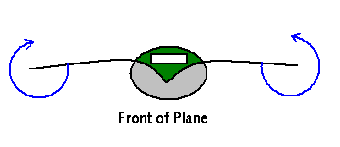
|
Trailing Vortices |
|
Now that we have looked at how the air flow act along the Frisbee, lets take a look at what happens when it leaves. |
| In order to understand the trailing vortices we must take a step backward. It was stated earlier that the Frisbee can be generalized to the scale of an airplane wing. As air flow from above the wing reattaches itself to the air flow from beneath, a turbulent flow can result, and if the angle of attack is high enough, vortices can result. |
| This can be seen almost any day. If you were to look up and see a plane flying at high altitude you might see twin white columns following the jet. Most people think this is the exhaust from the engines, but the true cause is from the wingtip vortices. As the air flow reattaches itself to one another, vortexes occur at the tips of the wing. (The white is from the water molecules in the atmosphere. The turbulent vortices actually try to reach a stable structure resembling "8", but that talk is for another time) |
|
|